I have a data sample (say 1.9 4.8 3.9 4.7 2.3 4.6 3.9)
I want to distribute the data on Bell Curve and give ratings between 1 to 5. How to do so using statistics.?
(The top 20% will be rated 5, then 4 and so on)
I have a data sample (say 1.9 4.8 3.9 4.7 2.3 4.6 3.9)
I want to distribute the data on Bell Curve and give ratings between 1 to 5. How to do so using statistics.?
(The top 20% will be rated 5, then 4 and so on)
Here's for the first part of your question:
x <- c(1.9,4.8,3.9,4.7,2.3,4.6,3.9)
sigma <- sd(x) # 1.175747
mu <- mean(x) # 3.728571
curve((1/(sigma*sqrt(2*pi)))*exp(-((x-mu)^2)/(2*sigma^2)),xlim=c(-1,9),ylab="density")
y <- (1/(sigma*sqrt(2*pi)))*exp(-((x-mu)^2)/(2*sigma^2))
points(x, y, col="red")

Second part
There's probably a more straightforward way to do it, but this does the trick:
p.quint <- qnorm(p = c(0, .2, .4, .6, .8, 1), mean = mu, sd = sigma)
names(p.quint) <- c(1:5, NA)
p.quint
# 1 2 3 4 5 <NA>
# -Inf 2.739038 3.430699 4.026444 4.718105 Inf
# Check how many items in p.quint are lower than p and use this as
# the index to p.quint's names and store it in x.quint
x.quint <- unlist(lapply(x, function(a) as.numeric(names(p.quint))[sum(a > p.quint)]))
cbind(x, x.quint)
# x x.quint
# [1,] 1.9 1
# [2,] 4.8 5
# [3,] 3.9 3
# [4,] 4.7 4
# [5,] 2.3 1
# [6,] 4.6 4
# [7,] 3.9 3
Previous answer for second part
[This was before OP mentionned desired output would represent quintiles]
Ok, I see what you mean now. So let's do like this:
x <- c(1.9,4.8,3.9,4.7,2.3,4.6,3.9)
# sort x to simplify matters
x <- sort(x)
# standardize x around its mean
x.tr <- x - mean(x)
# Check range ; we want it to be 4 (5-1)
range(x.tr)[2] - range(x.tr)[1] # 2.9
# Apply transformation to stretch the data a little bit
x.tr <- x * 4/2.9
range(x.tr)[2] - range(x.tr)[1]
# [1] 4
# We also want the min to be 1
x.tr <- x.tr - (x.tr[1]-1)
mu <- mean(x.tr) # 3.522167
sigma <- sd(x.tr) # 1.62172
x <- x.tr
curve((1/(sigma*sqrt(2*pi)))*exp(-((x-mu)^2)/(2*sigma^2)),xlim=c(-1,9),ylab="density")
y.tr <- (1/(sigma*sqrt(2*pi)))*exp(-((x.tr-mu)^2)/(2*sigma^2))
points(x.tr, y.tr, col="blue")
You now have your points ranging from 1 to 5 on a normal distribution with the following parameters:
mu
# [1] 3.522167
sigma
# [1] 1.62172
